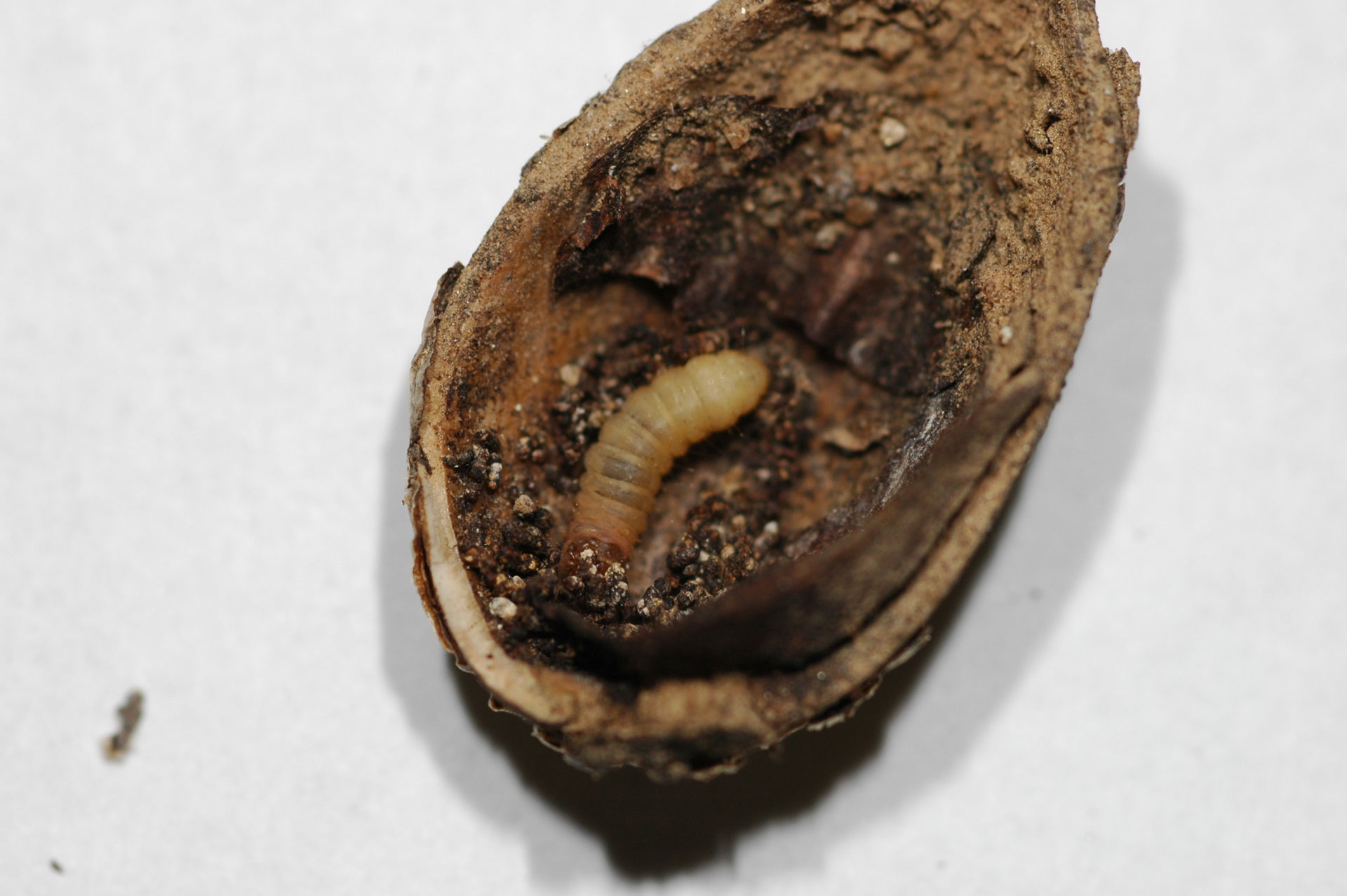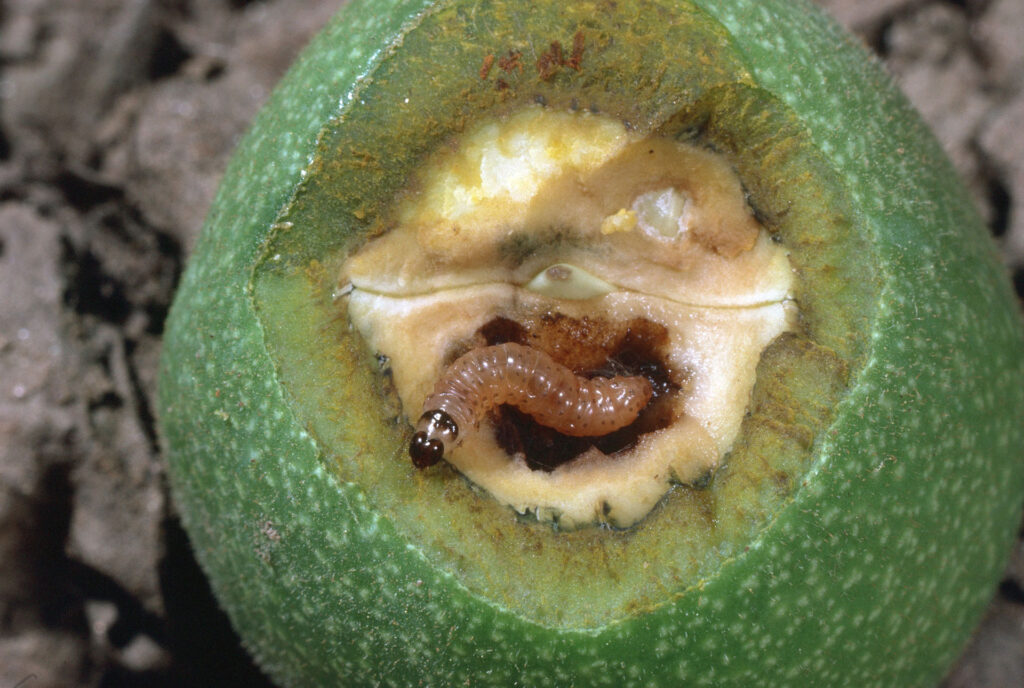
Quality expectations are high, market competition is intense and production costs are up. “Where does that leave tree nut growers and their pest control advisors?” asks UCCE Farm Advisor Franz Niederholzer.
In a Yuba-Sutter counties webinar series, Niederholzer noted that while markets are generally strong, maximizing net returns per acre is especially critical to economic sustainability in the almond industry.
Cost effective pest management, Niederholzer stressed, is the key to maximizing return per acre.
Insect pests that can cause economic damage in tree nuts fall into two categories: mobile and immobile. Leading the way on the mobile list of annual pests is, to no surprise, navel orangeworm (NOW). Codling moth (in walnuts), peach twig borer and Oriental fruit moth round out the annual list. Stink bugs are listed as occasional pests in tree nuts. The immobile list of pests includes protein ants, web spinning mites and scale.
Mobile Insect Pests
In Niederholzer’s hierarchy of tree crop insect and mite pests, NOW and codling moth are listed as difficult and challenging in terms of management. Biological control opportunities for NOW and codling moth are limited. NOW’s ability to affect crop quality and cause market loss makes this pest’s control critical.
Multiple approaches for monitoring NOW are important to accurately track pressure in an orchard. Mummy counts, egg traps, pheromone traps, evidence of damage and harvest samples are all methods of determining NOW populations. Pheromone traps and damaged nuts are used to track codling moth. Peach twig borer can be monitored by looking for emerging larvae at bloom, pheromone traps and harvest samples. Understanding the life cycle of worm pests helps with targeting management methods, Niederholzer said. NOW infests almonds at hull split. Their prime overwintering sites are mummy nuts on the tree or ground. Codling moth infests nuts early in the season, peach twig borer infests later in the season.

Niederholzer notes that there are many NOW control practices used or in development. Control from each is not equal, and one practice cannot make up for deficiencies in another. Orchard sanitation, timely harvest, hull split sprays, spring sprays, mating disruption and traps and combinations of these are used to keep crop damage at low levels. Harvest samples from windrowed nuts can give growers and PCAs an idea of how well the year’s control program worked.
Orchard sanitation and timely harvest are the two NOW management practices that are vital to preventing crop damage. Good sanitation in the fall or early winter sets the stage for reducing orchard NOW populations and gives other control measures a better chance of being effective. Niederholzer said cost per acre for orchard sanitation is about $235, while timely harvest adds no additional production costs. Early harvest plays a part in reducing the amount of damage from NOW and protein ants.
Hull split sprays can help reduce NOW numbers, but won’t eliminate this pest in the orchard. Sprays in June and July add $35 to $86 per acre in production costs. Due to NOW’s high mobility and the chances of NOW flying in from other orchards, reduction in populations will be 50% at best. In addition, Niederholzer said that broad-spectrum materials, which are less costly, cut down on predators for biological control of other insect pests. Softer materials are more expensive, but biological control of other pests remains an option.
Immobile Insect Pests
Immobile pests, such as ants, mites and scale, can be annual or occasional pests. Scale and mites are good candidates for biological control if orchards are managed without use of broad-spectrum insecticides. This allows populations of beneficial insects that prey on scale or mites to increase in the orchard.
Niederholzer said the management of immobile orchard pests should focus on monitoring for population levels followed by pesticide selection and delivery.
In the case of protein feeding ants, the percent of almond damage depends on the ant population and how long the nuts are on the orchard floor after shaking. In a graph, the number of ant colony entrances in a 5,000-square-foot section of the orchard and the number of days the nuts are left on the ground can estimate crop damage. If 45 colony entrances are identified, the crop damage can go from 1.4% in four days on the ground to 7% if nuts are on the ground for 21 days. Concerning economic damage, lost crop per acre, given a 2,500-pound crop at $2.50 a pound, goes from $87 in the four-day time frame to $437 in the 21-day time frame in the 45-colony scenario.
Crop damage due to ants can go undetected in the orchard unless a harvest sample is taken before nuts are picked up.
Ant bait is a good IPM practice, Niederholzer said, but it must be used correctly to achieve ant control. It should be applied to dry soil, and irrigation should not be done for at least 48 hours after bait is distributed. Baits also lose their attractiveness to ants over time and should not be stored. Weed management to minimize seed production removes another food source for ants, making baits more effective in control.
Hull split sprays and irrigation in the summer can take precedence over ant control, Niederholzer warned. Esteem, Clinch and Extinguish baits all need to be applied at least four weeks pre-harvest.
Beneficial insects and mites can provide biological control of spider mites. Web spinning mites are an annual concern in almond production. Management practices include monitoring to track mite populations as well as predator mite populations. Dry and dusty orchard edges are the most likely areas for mite infestations. Niederholzer said to wait until UC thresholds are reached to begin miticide sprays. A two-spray program is $80 to $100 per acre including spray costs.
When it comes to decisions on spider mite control, UCCE IPM Advisor David Haviland said that predator trap cards can assist in monitoring for predator numbers. Finding three six-spotted thrips on the predator cards in a week means mite populations will remain at the current level or go down, allowing a savings on a pesticide application.















